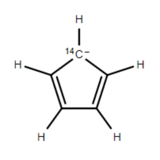 (Star represents $\ce{^14C}$ atom)
(Star represents $\ce{^14C}$ atom)
This figure represents three out of the five possible resonance structures. Of these five structures, four have a negative charge on a $\ce{^12C}$ atom whereas one has negative charge on $\ce{^14C}$ atom.
As the first premise, let's consider stability of the two kinds of resonating structures. The more stable the resonating compound, the more likely it is to be protonated.


We can compare stability using the premise of electronegativity (or rather charge density). According to this property, the more heavy an atom, the larger is its volume. If volume increases, the charge density decreases making it less likely to be able to stabilize the negative charge (becomes less electronegative). Due to this we can say that the resonance structure with $\ce{^14C}$ having the negative charge is less stable and so is less likely to be protonated.
Now, moving onto the second premise, the number of resonating structures containing the negative charge on $\ce{^14C}$ and $\ce{^12C}$ respectively.
If you notice only one resonating structure has a $\ce{^14C}$ with the negative charge, whereas there are $4$ resonating structures containing $\ce{^12C}$ atom with the negative charge. This would mean that probabilistically (considering stability to be equal) The resonance structure having a $\ce{^12C}$ with the negative charge would be more likely to be attacked.
Now, if we combine the two premises, we see that both stability and frequency of the resonance structure containing $\ce{^12C}$ with negative charge is greater its $\ce{^14C}$ counterpart. Concluding, we can say that the resonating structure with $\ce{^12C}$ stabilizing the negative charge would be more likely to be protonated.
Further Reading on how stability of isotopic compounds can be determined : Inductive effect of hydrogen isotopes




